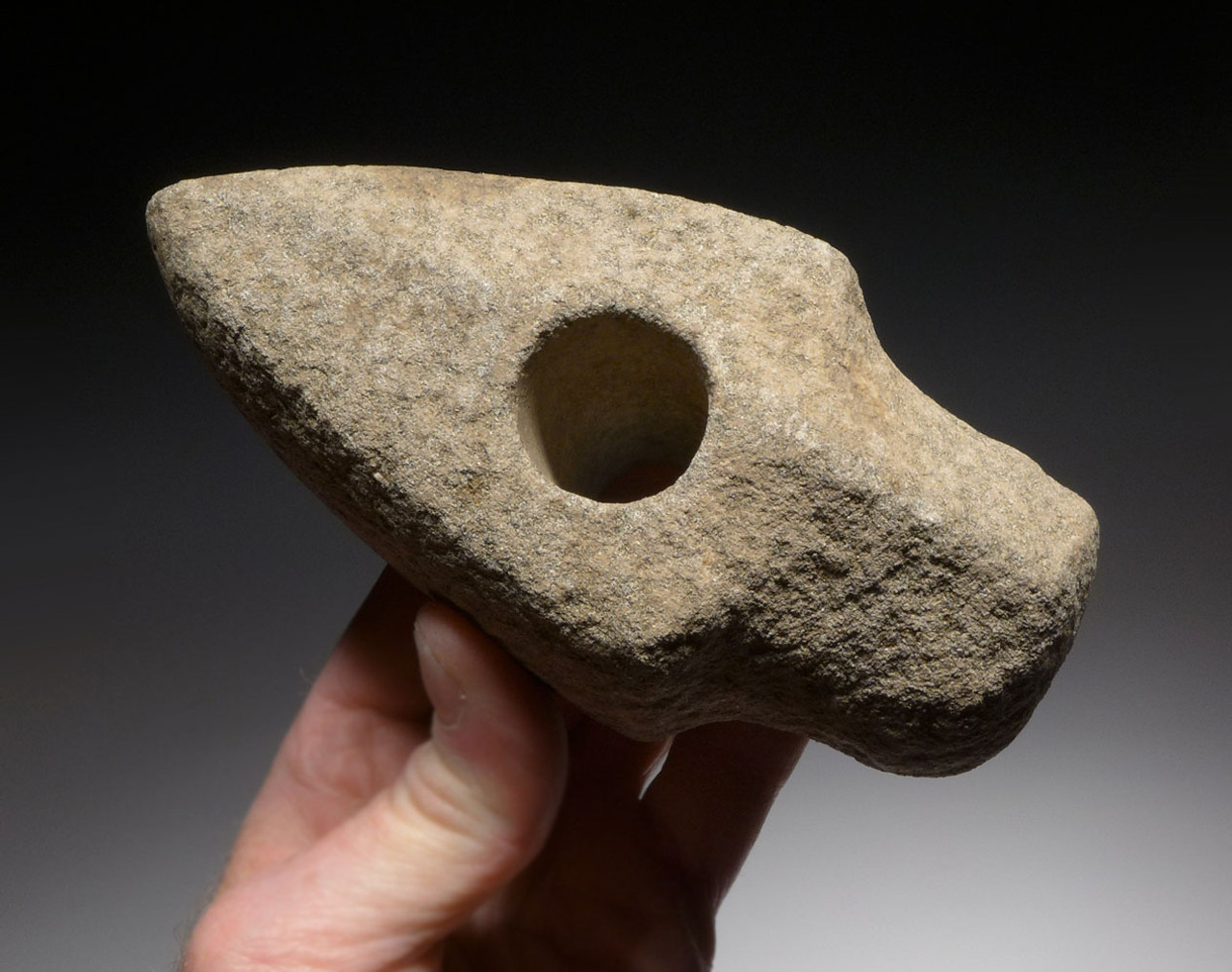Product Description
SEE MORE EUROPEAN NEOLITHIC ARTIFACTS
SEE MORE EUROPEAN BRONZE AGE ARTIFACTS
This rare, decorative perforated stone battle axe-hammer was found in Central Europe and comes from the Corded Ware Culture. This culture ranged in time from the Late Neolithic through the Chalcolithic, and into the Early Bronze Age. War axe-hammers like this were both, a weapon of prestige when embellished with decorative features as this one is, but also served as deadly effective weapons of war. Helmet or no helmet, large examples like this would have proven fatal with a single blow to the head, defeating the helmet armor and crushing the skull.
Made of hardstone and skillfully shaped with an aesthetic form and ridge dorsal surface, this Corded Ware battle axe-hammer features a slightly dropped chopping edge on one end, and a circular hammer striking end on the opposite side. It is in the finest preservation with all original features intact as originally made thousands of years ago. Examples like this were both prestige burial objects for the deceased, but also highly prized weapons in battle. We acquired only a small group of exceptional specimens, many years ago from an old German collection and once these few are sold, we will never be able to replace this quality that we are offering as of now.
We cannot emphasize enough to exercise considerable caution when encountering these axe-hammers on the market as forgeries abound! They are a classic, iconic weapon from this period and reproductions have been made for many decades, and sold to less knowledgeable buyers. There are more forgeries floating around the market than there are genuine specimens. While you can rub dirt over a modern ground copy, you cannot drive minerals deep into microscopic pores in the stone as authentic examples only possess. Furthermore, the sediment on original specimens cannot be cleaned off but a deep cleaning of a forgery will reveal modern grinding and crushing areas on the stone. Always deal with reputable and highly knowledgeable sellers that are able to differentiate a modern fake from an authentic specimen AND, get every purchase in writing with an unconditional guarantee of authenticity and correct identification, as we always provide.
HISTORY
The Corded Ware culture comprises a broad archaeological horizon of Europe between ca. 2900 BCE – 2350 BCE, thus from the late Neolithic, through the Copper Age, and ending in the early Bronze Age. The Corded Ware culture encompassed a vast area, from the contact zone between the Yamnaya culture and the Corded ware culture in south Central Europe, to the Rhine on the west and the Volga in the east, occupying parts of Northern Europe, Central Europe and Eastern Europe. The term Corded Ware culture is named after the cord-like impressions or ornamentation characteristic of its pottery.
Corded Ware encompassed most of continental northern Europe from the Rhine on the west to the Volga in the east, including most of modern-day Germany, the Netherlands, Denmark, Poland, Lithuania, Latvia, Estonia, Belarus, Czech Republic, Austria, Hungary, Slovakia, Switzerland, northwestern Romania, northern Ukraine, and the European part of Russia, as well as coastal Norway and the southern portions of Sweden and Finland. In the Late Eneolithic / Early Bronze Age, it encompassed the territory of nearly the entire Balkan Peninsula, where Corded Ware mixed with other steppe elements.
Archaeologists note that Corded Ware was not a "unified culture," as Corded Ware groups inhabiting a vast geographical area from the Rhine to Volga seem to have regionally specific subsistence strategies and economies. This culture included the Battle Axe culture and the Single Grave culture. There are differences in the material culture and in settlements and society. At the same time, they had several shared elements that are characteristic of all Corded Ware groups, such as their burial practices, pottery with "cord" decoration and unique stone-axes.
 US DOLLAR
US DOLLAR
 EURO
EURO
 AUSTRALIAN DOLLAR
AUSTRALIAN DOLLAR
 CANADIAN DOLLAR
CANADIAN DOLLAR
 POUND STERLING
POUND STERLING
























